As an Amazon Associate I earn from qualifying purchases.
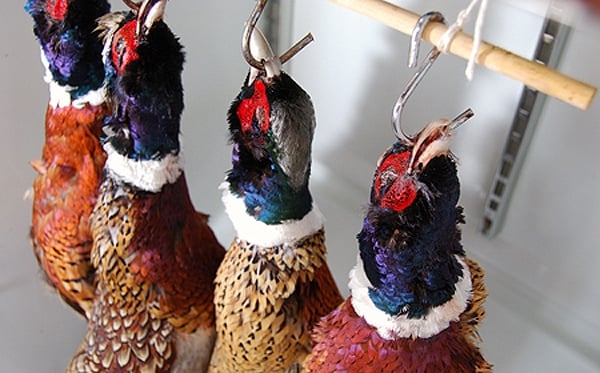
For several years after I began hunting, I recoiled at the idea of hanging game birds. The idea of hanging shot pheasants or partridges undrawn and in the feathers for days and days just did not seem terribly hygienic or sane to me. Old texts wax rhapsodic about the sublime flavor of “high” game, which usually means pheasants and usually means birds that have hung for more than a week. This, I decided, was madness.
I was wrong.
So I took a systematic look at the science of hanging pheasants and other game birds.
Nearly everyone who reads this space would probably agree with me that dry-aged beef is the finest expression of that meat. It is concentrated, savory and tender — and very expensive because dry-aging necessarily means a layer of crusty, slightly moldy ick on the outer edges of the meat. This is cut off before selling or serving.
Hanging beef and venison is important in part because these animals tend to be dispatched at about 18 months to 2 years old — old enough to get a tad tough on the teeth. Think about it: A whitetail buck sporting trophy antlers is likely to be 4 to 7 years old. Conversely, we don’t hang pork because hogs are slaughtered young. Ditto with domestic chickens. Young animals are already tender, so that aspect of aging isn’t needed.
Enter the pheasant. A pheasant really is a “ditch chicken.” It is a close cousin of the domestic chicken and when eaten fresh has, as Brillat-Savarin puts it in his The Physiology of Taste, “nothing distinguishing about it. It is neither as delicate as a pullet, nor as savorous as a quail.”
Those who have eaten fresh pheasant — and by fresh I mean un-hung — can’t help but thinking: “So what? This just seems like a slightly tough and slightly gamy chicken.” They are of course correct, especially with pen-raised birds.
So for my initial experiment I put our four pheasants in the salami fridge, which is set at 55°F. One had a big open spot on it where the breast skin had been ripped, so that bird I plucked after just one day. More on him later.
Off to the library. One of my idiosyncrasies (I have many) is that I collect game cookery books. I have many, and several discuss hanging pheasants.
The great Jean Anthelme Brillat-Savarin doesn’t give a timetable, but says, “the peak is reached when the pheasant begins to decompose; its aroma develops, and mixes with an oil which in order to form must undergo a certain amount of fermentation, just as the oil in coffee can only be drawn out by roasting it.” Sounds pretty hardcore.
Roy Wall wrote in 1945: “The flesh of either wild game or domesticated animals and fowl can certainly be improved by aging, but it is my opinion that there must be a limit to the aging process…aging in the open air for 10 days or a month, according to weather conditions, is, in my opinion, most beneficial to domestic and wild meat alike.”
Don’t freak out. Roy doesn’t specify what game he’s talking about there, and aging an old buck deer in proper conditions for a month isn’t such a crazy idea, although I’d prolly cut it down after two weeks. More recently, Clarissa Dickson Wright — one of the Two Fat Ladies, my favorite TV food personalities — says of pheasant: “Hang it you must, even if for only three days, for all meat must be allowed to rest and mature.” Clarissa’s preference is a week to 10 days.
The current Authoritative Source on All Things Meat is Englishman Hugh Fearnley-Whittingstall, who in his The River Cottage Meat Book says “four or five days would be about right for me” if a bird is hung at 55°F.
This is what the food writers say, but to me that’s only a piece of the puzzle. What about science?

Fortunately science exists on the topic of hanging pheasants and other game birds. My best source is an Australian government publication that did some rigorous experiments. For example:
Pheasants hung for 9 days at 50°F have been found by overseas taste panels to be more acceptable than those hung for 4 days at 59°F or for 18 days at 41°F. The taste panels thought that the birds stored at 59°F were tougher than those held for longer periods at lower temperatures. Pheasants hung at 50°F became more ‘gamy’ in flavour and more tender with length of hanging.
Aha! One issue solved. Food writers rarely talk about temperature of hanging because most of them think about hanging pheasants outside, which is fine if you don’t live in Arizona, Louisiana, Texas or California; even in autumn it is often too warm to properly hang game. It seems 50°F is ideal, and the 55°F my fridge is set at is acceptable.
Furthermore, an English study from 1973 found that clostridia and e. coli bacteria form very rapidly once you get to about 60°F, but very slowly — and not at all in the case of clostridia — at 50°F.
That same study found that field care of the birds is vital. Under no circumstances should you allow pheasants to pile up in warm conditions because doing so will slow cooling so much that the dead birds will develop bacteria in their innards. This is no bueno.
All the bacteria and taste tests converge on two things: 50 to 55°F and 3 to 7 days. That’s your takeaway, folks.
Left undiscussed is the importance of feathers and innards. Brillat-Savarin speaks about a mysterious “oil,” and Wall talks about bacterial decomposition. Here’s my take: The feathers provide protection for the skin against drying out during aging. Pluck the feathers right away and you can still age the bird, but the skin will be unacceptably dried out and unusable.
As for the guts, I am on the fence here. I think they do add something: Fish guts will affect the fillets because of the animal’s digestive enzymes. No reason to think land animals aren’t the same way, although at 50 to 55°F this is going to take some time to develop — for what it’s worth, a pheasant’s body temperature runs about 105°F.
Yet, when I plucked and gutted my experimental pheasants I noticed two things: One, they were pretty dry inside, and two, the innards in three of the four birds looked fine and wholesome, not ratty and stinky. Maybe this je ne sais quoi does not appear until later.
All of which brings me to my own experiments with hanging pheasants. Like I mentioned before, I had one damaged bird I let hang for only a day. This bird’s body was drier and tighter than a fresh-killed bird, and I dry-plucked it because of the damage.
This pheasant went into a pheasant and pork pie, which turned out to be an outstanding dish. Hat tip to Fergus Henderson for the inspiration on this one. How was the pheasant? I noted two things: One, the bird browned better (less moisture?), and it was more flavorful — even after just one day.
That left three birds. I plucked the next one at three days. This is the beginning of the sweet spot in the Australian study. I noticed that this bird was pretty limp, but there was no bad smell and the fat and giblets looked pristine. I was, honestly, pretty shocked. I jointed this bird because that’s what I do with most pheasants; the legs and thighs always need more time than the breast.
The aging really came into play with the breast. It was soft, not unpleasantly so, but definitely less firm than the day-old bird or a fresh one. Then it hit me: These pheasants were pen-raised and had only been wandering around wild for days or weeks (months at the most). They were all young birds. I had originally planned to leave one bird for a full week, but scotched that idea immediately. I plucked the next two birds at 3 1/2 days and 4 days. I kept both whole.
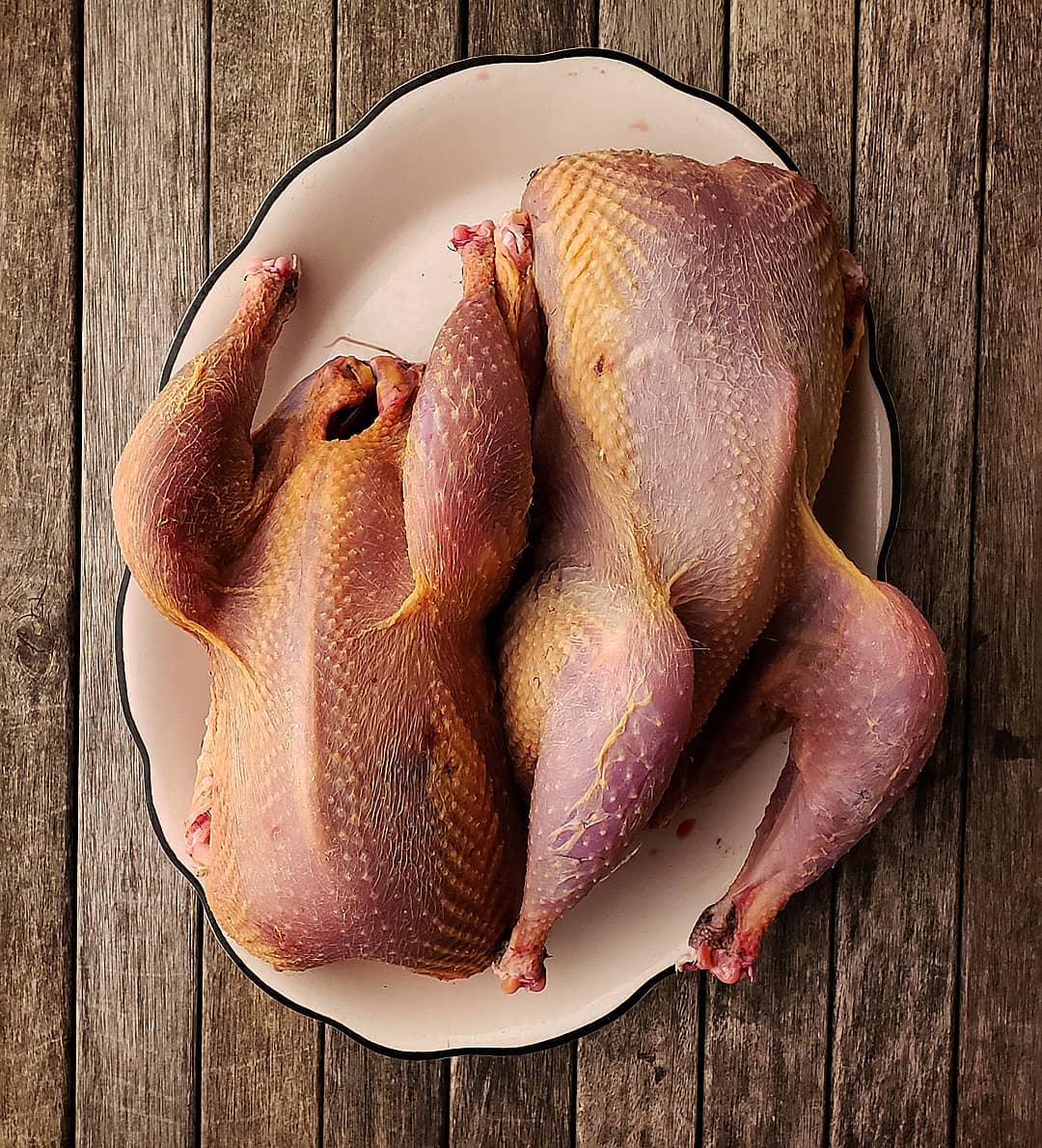
I’ve since done experiments on old roosters and they can be successfully aged for a full week. In fact, if you get an old, wild pheasant, 3 days would be a minimum for proper aging.
This of course with other game birds. Over the years I’ve come to these conclusions on hang time:
- Pheasants, grouse, partridges, turkeys and geese I will hang 3 to 7 days, depending on how old they were. If you hang turkeys or geese you must eviscerate them, as they retain too much heat otherwise.
- Pen-raised pheasants, all quail, woodcock, snipe and ducks I only age 1 to 3 days, again, depending on size and age. The smaller the bird and the younger the bird, the shorter the hang time.
And, to be honest, I rarely age my waterfowl this way anymore. If I want to age them, I do so in the fridge. The problem with ducks and geese is their down: It causes the birds to retain heat too long, and I end up getting a bit of gangrene on their butts, which is no bueno.
A few things you should know. Don’t try to wet-pluck an aged game bird as I instruct you to here. You must dry-pluck these birds because the skin gets looser and scalding did not seem to help one bit with the feathers. It was a major bummer to scald one bird and rip some of the skin. Dry-plucking, you should be warned, sucks. It takes forever, but is worth it for the results.
To eat the giblets or not? I’d say go for it for birds up to three days, if they have not been shot up. Any sign of ickiness in the innards and toss them at once. One way to tell if you are unsure is to render the fat the way you would with a duck. If it stinks, toss it.
So, to wrap up, here’s what I found:
- Keep your birds as cool and as separate as possible in the field. Use a game strap, not the game bag in your vest. Separate your birds in the truck or put them in a cooler — do not get them wet!
- Hanging your birds by the neck or feet does not matter, as several studies has shown.
- Hang upland birds between 50 to 55°F for at least three days, up to a week with an old rooster. Old roosters will have horny beaks, blunt spurs and feet that look like they have been walked on for quite some time. They will also have a stiff, heavy keelbone. Hen pheasants only need 3 days.
- Do not hang any game birds that have been gut-shot or are generally torn up. Butcher these immediately and use them for a pot pie.
- Dry-pluck any bird that has hung for more than 3 days.
- Wash and dry your birds after you pluck and draw them. Only then should you freeze them.
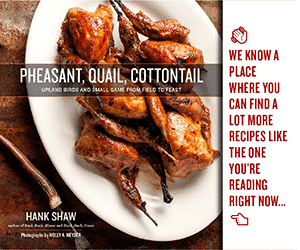
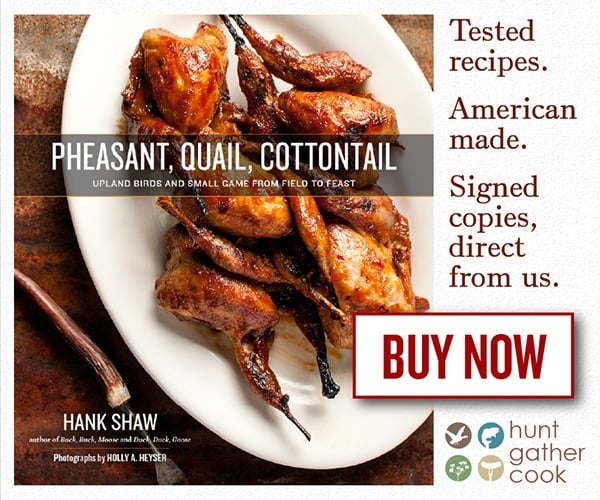
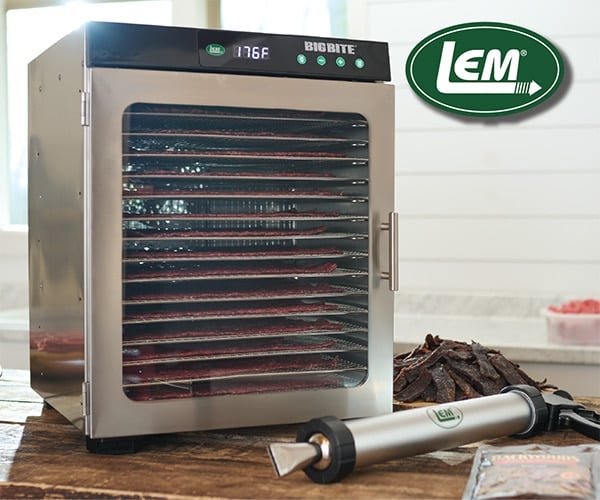
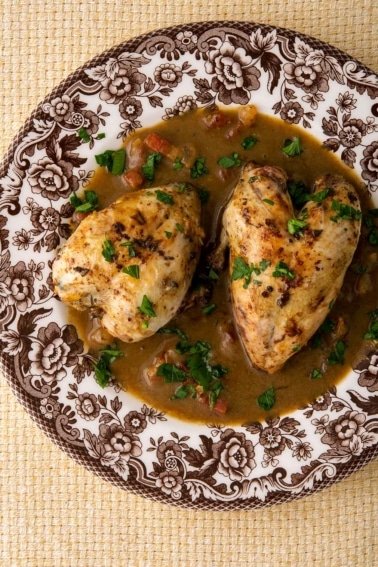
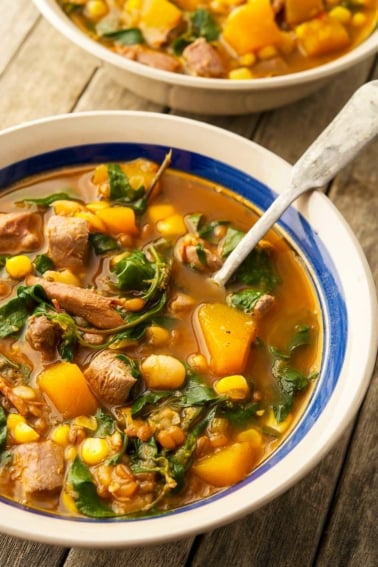
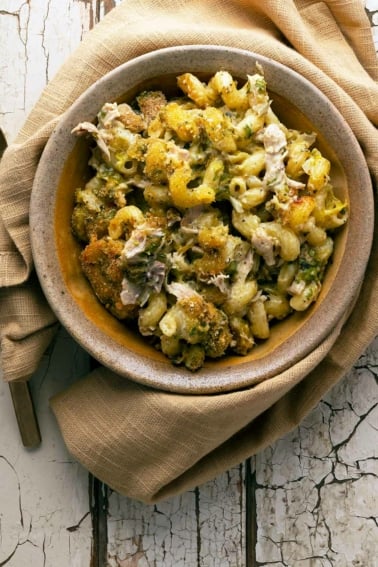
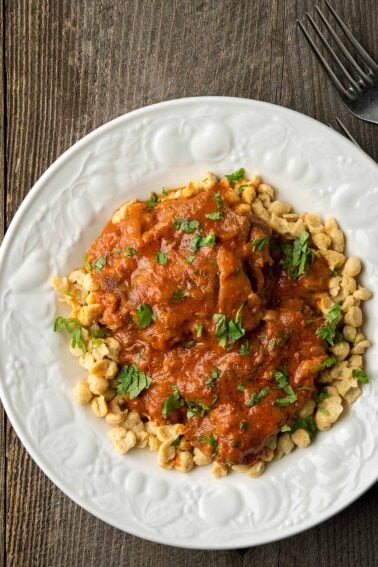
For geese or ducks, specifically Canada Goose, before reading your post I’ve historically hung them in the garage (35-50 degrees) depending on November /December weather here in Northern IL, and they aged just fine. I understand the down might retain heat, but these birds shot in late fall/ early winter have had a chance to “fully cool off”, since they’re not in a heated blind or anything. Would that influence your decision on letting them aged un-eviscerated?
Dave: Sure, if it works. It’s just too warm in many other places.
Should large muscovy drakes be eviscerated?
Crystal: I would. They are big birds.
Do You eviscerate your ducks/waterfowl? Or just straight into the fridge?
Sean: I normally leave ducks whole, but I eviscerate geese.
If I’ve taken the head off of my quail, can I still hang it?
Flippy: Yes, by the feet.
I usually hang by the head in a cellar with newspaper beneath. When they start discharging exudate I pluck and gut and trim out any badly decomposed areas.
Always turn out to perfection.
Hi Hank
Does disease or illness in a bird affect it’s eatability? And how would you recognise such issues?
Thanks.
Maria: I’ve never even heard of anyone ever shooting a diseased game bird.
Just tried this with a pheasant, problem I had is the the shot carried feathers into the breast and leg meat which I didn’t feel great about after a week, also I got some gangrene around the butt. Maybe reserve this for head shot birds? Or so you just cut around the bad and carry on?
Mike: I cut around the bad and carry on.
Greetings Hank
I have always aged my birds when conditions allow. Guts in, guts out, depending on conditions. Best birds I ever ate were 2 woodies I jumped while squirrel hunting. 2 weeks in the beer box on news paper, guts in, clean dry birds not gut shot. I rotated them belly up, belly down every couple days. Picked them, gutted, (no smell, actually sweet smell, good!) , dried, split up the back, cracked flat open, salt, pepper, olive oil rubdown,(no bacon grease on hand) put on metal steak plates and broiled turning once about 15-20 minutes at 450 . Wife and I chowed down. Best ever! Drooling remembering. Cooking 6 bluewings now 2 weeks in fridge plucked and gutted. aging is the only way to go. Bon appetit
After reading some of your articles a couple of years ago I decided to let my ducks (and coots) sit in the fridge for about 3 or 4 days, unless they are really shot up. I was shocked at the difference it made. I do not have a lot fridge room, so I keep them as spread out as much as I can and try to keep them fluffed up.
I have been out of the USA for a while but will be returning this fall and cannot wait to get back on the marsh. Have had hunting on the brain and decided to see what new stuff Hank Shaw had going on. Greetings from Costa Rica : )
Have you attempted this with wild turkey? Very curious if this would improve the taste of a big old Tom.
Ryan: Yes, but you need to gut the bird in the feathers. Turkeys are large enough to hold too much heat within themselves, and gutting cools the carcass down fast. Smaller birds don’t need this.
When I lived alone and hunted ducks more than I do now I would come home tired from hunting and put the few mallards (only duck I shot at the time) I’d shot on the refuges in the lower rack of the frig and go to bed. They’d be unplucked and ungutted. I’d let them accumulate until I’d have 10 to 15 birds and maybe a few geese sitting in the frig. The mallards would be as old as 30 days with black bills instead of the fresh banana color. I’d take pictures of the pile in the frig and send them as Christmas cards to hunting friends which grossed them out. I came up with several simple rules and observations.
1. If they were wet birds, as they often were, put them on newspaper in the frig and let them dry for a day and then comb their feathers backward with your hand to reestablish the air space between the body and the feather covering’s outer surface.
2. Try to separate the birds until they have chilled for a couple of days and then you can stack them on top of each other. That allowed the skin to dry.
3. After 20 days or so the surface of the skin sometimes begins to liquefy a little. It doesn’t seem to hurt the bird other than making it more messy to pluck.
4. Dry pick them as noted.
5. NEVER gut them! They’ll spoil even in the frig within 3-4 days. It’s anaerobic vs. aerobic bacteria and aerobic bacteria always win the race to putrescence.
6. Although I love them, I never ate the guts but only because I was a coward after they were 5 days in the frig. They always looked fine but…
I’ve heard of guys who never picked their birds and put them undrawn and fully feathered in the freezer claiming they don’t get freezer burned due to the down and have kept them frozen for a year that way. Never tried it as I never had the freezer room for the 30-35 rice fed mallards I’d shoot as my maximum ducks for the year. I was the only one who ate them so only shot enough to feed my duck hunger and not get tired of them over the off season.
I’d fillet the two sides off the bird leaving nothing on the skeleton. I’d pan render the fat on each half for later use frying and finish to rare in the oven or stove top. The meat was always not bloody like a fresh bird is and had great flavor. The fat was as good as a fresh bird.
Hank,
I have two of your books and love your website. Everything I have made has been great! I am a scientist so I like that you include info from scientific papers. The concern I have with aging meat is that I am sure the animals used in controlled studies are not killed as in hunting. While you advise against hanging gut shot animals, I think bullet penetration through any edible part could result in spoiled meat. This could not only be distasteful, but potentially dangerous. If you think about it, a bullet, arrow or birdshot will pull feathers and fur from the outside of the animal into the interior of the meat. I frequently have to pull feathers out of meat. As a result, that tissue is inoculated. While some bacteria are inhibited by 50 degree temps, not all are; if they were, food would never go bad in the fridge. So I think it makes sense to hang a bird shot only in the head. Otherwise, I am skeptical if is should be hung. Thoughts?
Mark: They are from shot animals in those studies. Hanging has been done successfully for 1000+ years. It works. If you’re uncomfortable with it, don’t hang yours.
Hi Hank,
A friend of mine works for Steve Rinella and suggested I check out your books and recipes. I have a setter and do a fair amount of bird hunting so I am interested in your bird recipes. I am intrigued about hanging birds as you suggest and mentioned it to a couple of my hunting buddies last weekend while hunting. We all decided we would like to give it a try, but i do have a question if you could perhaps answer. How the heck do you tell if a bird is gut shot without plucking it some? Is it ok to pluck a little to be sure? For the life of us we just can’t decide how you can determine a gut shot bird! Thanks for sharing your recipes, hope to see you in person some day.
Joel: You don’t have to be too thorough in your search. Feel around the tail/vent for blood. If you get it, pick the bird right away. If not, you can hang it.
Not sure about this at all. I bought a pair of ducks, rather small ducks from France, wild duck that had been trapped. Cost a fortune. However when i took them out their package they feel slimy and smell rotten. Is this normal. Not sure if I should cook them or toss them. Could they just be high or are they rotten. The breasts feel very soft. I don’t speak French but the seller told me they were the best with many wild hand gestures. They were in a chiller and I put them in mine for a day after buying. I just don’t like the slimy and smell!!??? Its the same slimy sticky feel when cooked ham goes off, which must be bacteria……I’ve never heard of hanging duck but who knows!? Anyway I have nothing else to serve my guest so here goes. I suppose if they still stink after cooking I will bin them and get my guest drunk on red wine instead. That way they wont notice that all there is is crusty bread.
Anton: No, that is not normal at all! That sounds gross. I suspect the birds are very “high,” and that is an acquired taste. I’ve never been brave enough to cook one that nasty. I generally hang birds for a few days. That sounds like it was hung for a few weeks!
Why can’t you ‘age’ a Pheasant that has been dressed/entrails removed? We don’t age beef that has not been dressed out/gutted?
Elivs: You can, sort of. I’ve kept dressed pheasants in the fridge for several days and it helps, but birds are not mammals. They age differently. You also have a mass issue: A pheasant is maybe 3 pounds. So it cools fast. Large animals have too much thermal inertia to age this way.
Can you age it in the fridge or do they need to hang at 50 degrees?
Yup: Yes, you can age in the fridge. I do that when my “hanging fridge” is otherwise occupied.
Thanks for your very scientific approach to hanging pheasants. The rush to eviscerate fowl is a mistake. If the “green” matter is intact the enzymes in the flesh will work wonders without risk of contamination. We are all familiar with aged beef. and the benefits of time under the right conditions. I am just a little concerned about the temperature you allowed the fowl to age at. 40 degrees F and below allow for the action of enzymes but inhibit bacteria. For the sake of food safety, I keep it around 38 degrees. Also, God gave us a nose for a reason. Use it. 10’s of thousands of years of evolution went into its development, you can trust it. I know bad when I smell it.
Hank-
If you plan on smoking your pheasants, do you still hang them first?
Thank you in advance!
Casey: You can. But you don’t have to.
Great post! We had some hunters from England come to Minnesota to hunt Woodcock and they let them hang as long as they were here, we thought they were crazy! Good information from you.
Hello, I love your blog and I was happy to see this article as the first hit when I googled hanging birds!
Thank you for sharing all of your hard work. It has jump started my experience in several areas.
I am interested in hanging my old chickens. We usually just make them into stock. I was wondering if hanging them might make them more edible or at least add another dimension to my stock. It sounds like everything you’ve said here would apply.
I was wondering about scalding the.birds prior to hanging to make plucking easier but I see your mention of keeping them dry.
I am also wondering about slaughter. Would a headless or throat cut bird be safe to hang or would the wound be a problem? I could twist their heads but that’s a bit less pleasent.
Lastly aside from the culinary, there’s a storage / preservation aspect here. Condition aside, is there a safe maximum amount of time to hang a bird under good cellar conditions?
Thanks again!
Jason
Jason: Yep, you can hang old chickens. I’d do it up to a week in the right conditions. I’d neck twist them to slaughter, but if you throat slit them, hang the birds from the feet. Leave the heads on. Hope that helps!